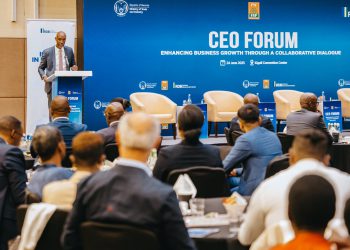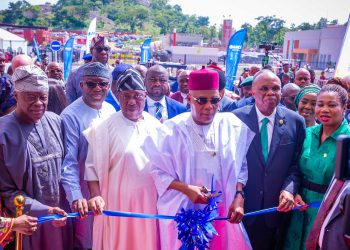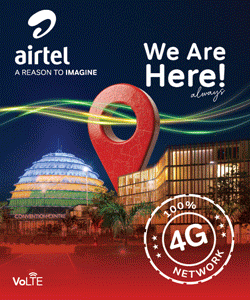Morocco is back into the African Union after tiresome discussions with the continental body. At 9:00AM, Monday, 13 March 2017, at the AU’s Headquarters, Morocco’s flag was again blown by the winds of Addis after 33 years.
“Today, we raised the flag of Morocco at the AU Headquarters, another step to welcome the Kingdom back to the institutional family,” Dr. Nkosazana Dlamini Zuma, the outgoing Chairperson of the African Union Commission said in a tweet on Monday Morning.
Eelier, Rwanda’s President Kagame, who now heads the AU’s reform commission, said: “With the re-admission of Morocco, the African Union includes every country on the continent for the first time in history.”
On February 1, 2017, the African Union decided to allow Morocco back into the fold after a 33-year absence, despite stiff resistance from some member states over the status of Western Sahara.
After an emotional and tense debate, member states decided by consensus to leave the question of the disputed territory of Western Sahara for another day, and resolve it with Morocco “back in the family”.
Lamine Baali, ambassador of Western Sahara to Ethiopia and the AU said then that, “Morocco has been admitted to join the AU with a view that it will become the 55th member of the continental body. That’s made with the understanding that Western Sahara will remain a member of the AU.”
“All the debates were focused on [the issue] that Morocco should respect the internationally recognised border of Western Sahara.”
Morocco left the AU, which was then called Organisation of African Unity, in 1984 after the body recognised the independence of Moroccan-occupied Western Sahara.
Morocco submitted its bid to rejoin in 2016, reportedly in the hope that being inside the AU would bring it diplomatic gains against Western Sahara’s independence movement; the Polisario Front, and allow it to lobby against Western Sahara’s membership in the AU. But Baali said Morocco had been re-admitted “with the understanding that Western Sahara will remain a member of the AU”.
The membership of relatively wealthy Morocco was welcomed by many members of the AU, which has been criticised for being overly dependent on non-African donor funding. The reform common which President Kagame heads, is studying options with which member states will fund the organisation’s bills.
How Morocco’s flag rose up






Morocco Facts Sheet
Morocco is an ethnically diverse country with a rich culture and civilisation. Through Moroccan history, it has hosted many people coming from East (Phoenicians, Carthaginians, Jews and Arabs), South (Sub-Saharan Africans) and North (Romans, Andalusians). All those civilisations have affected the social structure of Morocco. It hosts various forms of beliefs, from paganism, Judaism, and Christianity to Islam. Culturally speaking, Morocco has always been successful in combining its Berber, Jewish and Arabic cultural heritage with external influences such as the French and the Spanish and, during the last decades, the Anglo-American lifestyles. Women are at times sexually harassed when walking the streets; a woman walking the streets of Casablanca while filmed by The Moroccan Times was harassed about 300 times.
Population: 34 million people
Land: 710,850 KM²
GDP: $103.8 billion
GDP (PPP): $274.53 billion
Per capita: $8,194
Economy: Morocco’s economy is considered a relatively liberal economy governed by the law of supply and demand. Since 1993, the country has followed a policy of privatisation of certain economic sectors, which used to be in the hands of the government. Morocco has become a major player in the African economic affairs, and is the 5th African economy by GDP (PPP). Morocco was ranked the 1st African country by the Economist Intelligence Unit’ quality-of-life index, ahead of South Africa. However, Morocco has since then slipped into fourth place behind Egypt, but ahead of Angola. Government reforms and steady yearly growth in the region of 4–5% from 2000 to 2007, including 4.9% year-on-year growth in 2003–2007 helped the Moroccan economy to become much more robust compared to a few years ago. For 2012 the World Bank forecasts a rate of 4% growth for Morocco and 4.2% for following year, 2013. The services sector accounts for just over half of GDP and industry, made up of mining, construction and manufacturing, is an additional quarter. The industries that recorded the highest growth are tourism, telecoms, information technology, and textile.
Languages: Arabic and French. French is used in official government documents and the business community, although it has no official status.
Climate: The country’s Mediterranean climate is similar to that of southern California, with lush forests in the northern and central mountain ranges of the country, giving way to dryer conditions and inland deserts further southeast. The Moroccan coastal plains experience remarkably moderate temperatures even in summer, owing to the effect of the cold Canary Current off its Atlantic coast. In the Rif, Middle and High Atlas Mountains, there exist several different types of climates: Mediterranean along the coastal lowlands, giving way to a humid temperate climate at higher elevations with sufficient moisture to allow for the growth of different species of oaks, moss carpets, junipers, and Atlantic fir which is a royal conifer tree endemic to Morocco. At higher elevations, the climate becomes alpine in character, and can sustain ski resorts.
Biodiversity: Morocco has a wide range of biodiversity. It is part of the Mediterranean basin, an area with exceptional concentrations of endemic species undergoing rapid rates of habitat loss, and is therefore considered to be a hotspot for conservation priority. Avifauna are notably variant. The avifauna of Morocco includes a total of 454 species, five of which have been introduced by humans, and 156 are rarely or accidentally seen. The Barbary lion, hunted to extinction in the wild, was a subspecies native to Morocco and is a national emblem. The last Barbary lion in the wild was shot in the Atlas Mountains in 1922. The other two primary predators of northern Africa, the Atlas bear and Barbary leopard, are now extinct and critically endangered, respectively. Relict populations of the West African crocodile persisted in the Draa River until the 20th century. Because of the proximity of northern Morocco to Europe, species such as cacti, tortoises, mammal skins, and high-value birds (falcons and bustards) are harvested in various parts of the country and exported in appreciable quantities, with especially large volumes of eel harvested – 60 tons exported to the Far East in the period 2009‒2011.
Politics: Following the March 1998 elections, a coalition government headed by opposition socialist leader Abderrahmane Youssoufi and composed largely of ministers drawn from opposition parties was formed. Prime Minister Youssoufi’s government was the first ever government drawn primarily from opposition parties, and also represents the first opportunity for a coalition of socialists, left-of-centre, and nationalist parties to be included in the government until October 2002. It was also the first time in the modern political history of the Arab world that the opposition assumed power following an election. Abdelilah Benkirane heads the current government. The Moroccan Constitution provides for a monarchy with a Parliament and an independent judiciary. With the 2011 constitutional reforms, the King of Morocco, now Mohammed VI, retains less executive powers whereas those of the prime minister have been enlarged. The constitution grants the king extreme powers; he is both the secular political leader and the “Commander of the Faithful” as a direct descendant of the Prophet Mohammed. He presides over the Council of Ministers; appoints the Prime Minister from the political party that has won the most seats in the parliamentary elections, and on recommendations from the latter, appoints the members of the government. The previous constitution of 1996 theoretically allowed the king to terminate the tenure of any minister, and after consultation with the heads of the higher and lower Assemblies, to dissolve the Parliament, suspend the constitution, call for new elections, or rule by decree, the only time this happened was in 1965. The King is formally the commander in chief of the military.
Military: The army has 195,800 active troops and 150,000 reserve forces; spending 3.47% of the national budget US$3.37 billion. Compulsory military services were suspended in Morocco since September 2006, and Morocco’s reserve obligation lasts until age 50. Morocco’s military consists of the Royal Armed Forces; this includes the Army (the largest branch), the Navy, the Air Force, the Royal Guard, the Royal Gendarmerie and the Auxiliary Forces. Internal security is generally effective, and acts of political violence are rare (with one exception, the 2003 Casablanca bombings that killed 45 people. The UN maintains a small observer force in Western Sahara, where a large number of Morocco’s troops are stationed. The Saharawi group Polisario maintains an active militia of an estimated 5,000 fighters in Western Sahara and has engaged in intermittent warfare with Moroccan forces since the 1970s.
Health: In 2010, spending on healthcare accounted for 5.19% of the country’s GDP. In 2009, there were 6.46 physicians and 9.28 nurses per 10,000 inhabitants. The life expectancy at birth was 74 years in 2013, or 72 years for males and 76 years for females.



















